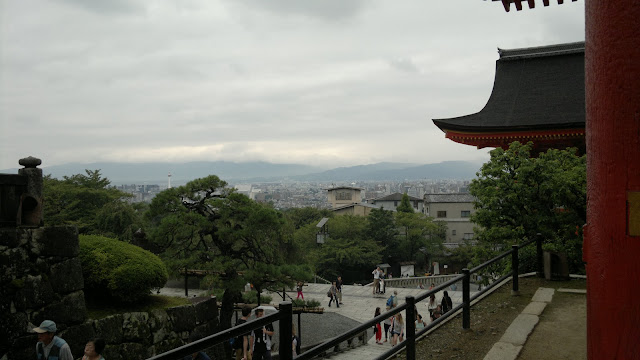After leaving Ryoan-ji, I was ready to call it a day. I had fulfilled my long held wish and had a touching and unexpected experience.
I was at peace.
But ... the bus we were on stopped right in front of the entrance to Kinkaku-ji, Kyoto's famous Golden Pavilion and another UNESCO World Heritage Site.
This was the very place we were on our way to yesterday when we had gotten completely lost.
Now that we were right on its doorstep, it seemed a gift from Buddha -- a second chance.
It was almost closing time when we arrived and there were not too many tourists who were lined up at the entrance. We walked past this large and impressive building but had no time to stop.
This magnificent sight came as a total shock. Jay had visited Kinkakuji many many years before and somehow he vaguely remembered how it looked like. For a first timer like myself, it was incredible, amazing and completely impressive.
Very different from the effect that Ryoanji had on me -- while that was a silent and serene gift -- this was an exuberant and over the top present. I could not stop smiling.
This Zen temple formerly belonged to a wealthy and powerful shogun who willed it to the Rinzai sect upon his death in 1408. Unfortunately, this structure that we see today is no longer the original as it has burned to the ground many times.
The most famous destruction occurred in the 1950s when the building was set on fire by a fanatic monk.
Rebuilt in 1955, the gold leaf covering has actually been enhanced from the original layer, to make it even more golden, even more impressive.
The Golden Pavilion is the highlight, the be-all and end-all of Kinkakuji. After the initial wow moment, you slowly come down from the visual high as you walk through the rest of the well laid out temple grounds. We were captivated by this heron, who stood in the pond's shallows.
Across Kinkakuji is the head priest's quarters, known as the Hojo. While it is closed to the public, you can peep through and see the beautiful and traditional Zen garden -- of painstakingly raked sand, moss and well placed shrubbery.
A small waterfall pours into a pond creating a never ending sound of running water.
I came upon this man throwing coins at these statues. Apparently, if you hit a statue or better yet, if your coin falls into the cup, luck will smile on you.
The sun has almost set and visitors are being politely but firmly led out ... it's closing time.
I take a last look at the Golden Pavilion. From this far point, it looks so small and ordinary -- the gold has faded to a plain yellow color.
Beauty can be extremely striking -- but it is also quite fleeting.


















































